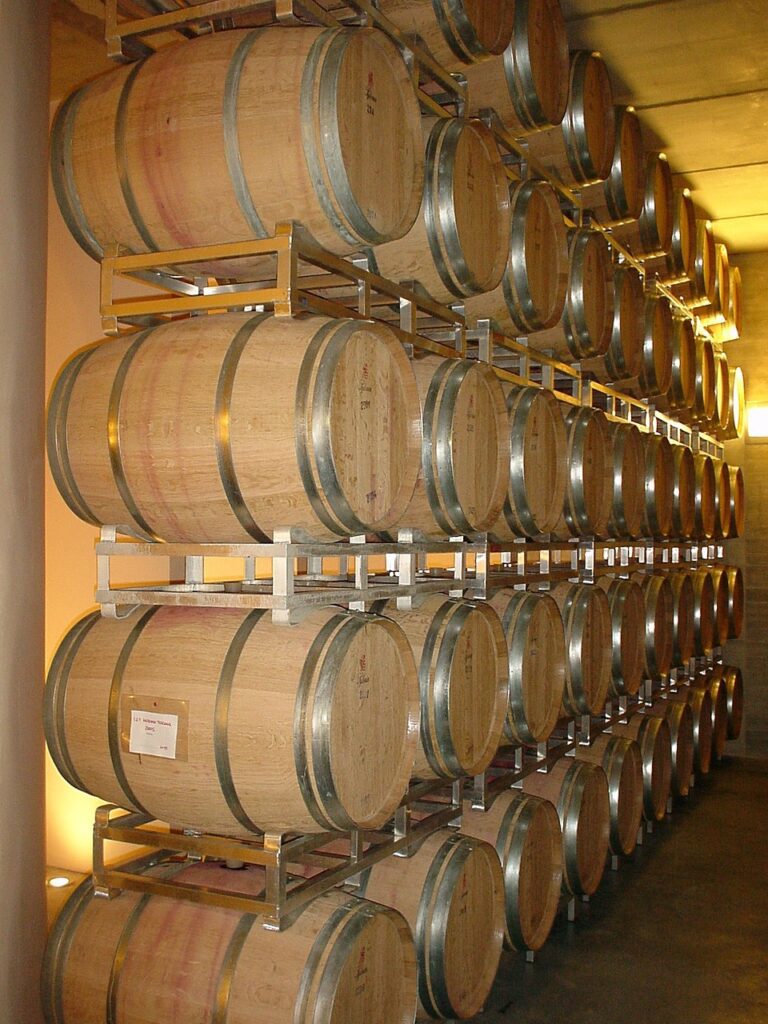Although the occurrence of TCA (or ‘cork taint’) in bark can be diminished considerably by the implementation of certain actions in forests, it can be diminished further by actions in factories.
In a previous article the actions initiated by the cork industry in forests to address the TCA-problem (TCA = 2,4,6-trichloroanisole) were discussed. In this article the focus is on the actions that were implemented in factories to limit the same problem.
The majority of bark from the forests is delivered in truck loads at the factories. Some of it is stacked on pallets. It is tagged clearly to trace its origin. The bark is then stacked on concrete surfaces or pallets under the roof or outside the factory.

The quality of traditional natural corks is improving with cutting-edge technology. (Courtesy of Amorim).
The most bark is usually processed in the same year as when harvested. In the early days, the bark was dumped in a boiling water bath to soften it and remove major contaminants. In the 1980s it was established that TCA can be dissolved in water. This could have caused one bark plank to contaminate a lot of planks.
This process consequently had to be adjusted. The installation of autoclaves was one of the first steps. The use of an autoclave ensures that water boils at a higher temperature.
Due to the higher temperature, more volatiles can be extracted from the bark. The water is also treated before recirculation to prevent the potential transfer of TCA. A single process is however not sufficient to prevent TCA-contamination and a combination of steps is required.
After the autoclave treatment, the bark is sliced in widths equal to the length of required closures. Stoppers are then punched from the bark slices and exposed to a range of physical quality inspections, which are executed manually or mechanically.
The waste bark is used for agglomerated cork products or for fuel for energy generation. Until now no internal structure elements could be found to determine the ease of extracting a cork closure from a bottle.
The visual specifications of closures are determined by the individual companies. It includes amongst other the number, size and orientation of the lenticels.
Different apparatus are used to sort the individual corks based on their visual appearance. It must however happen rapidly to make the production output of the factory as high as possible.
Further sorting of the corks also differs between different companies. It can amongst others include a steam vacuum and ozone washing. The purpose of the first mentioned is to create a higher effective pressure differential in order to drive out the TCA.

Cork innovation: say goodbye to TCA
After these treatments, products are packaged in different ways which differ for local or export markets. Export orders are usually packaged in larger bales. Different surface treatments are offered to improve the corking and extraction of bottles and branding can be done according to the client needs.
As a result of the TCA-problem, companies had to add value to their activities in the 1980s. This led to the development of the 1+1 closure. A thin disc on the rest of the closure, consisting of agglomerated cork, is in this case the contact surface of the cork and the wine.
Agglomerated closures could however increase TCA-contamination if some of the agglomerate granules contain high TCA-concentrations, which could migrate to the rest of the closure. In the case of the 1+1 closure, the contact disc could however be made from bark, with a known low TCA-concentration.
This can prevent this migration. Seeing that the discs consist of larger bark chunks, it is more difficult to remove the TCA completely.
When the 1+1 closure is also extracted from the bottle, after it has been closed for a long time, the structure of the closure can also be damaged. Seeing that it is easier to remove TCA from smaller granules and the techniques of TCA-removal have been improved, more attention is given to agglomerated corks again.
This has led to the development of so-called micro-agglomerate closures. It is produced by molding cork granules together with other components and bounding it with heat. The composition of these closures can also be adjusted to diversify the oxygen transmission rate or OTR for different wine types and bottle maturation periods.
The main challenge for the cork industry remains the responsible management of the TCA-problem to protect their role as providers to the wine industry The identification and development of methods to observe TCA in cork are however difficult.
The human nose is sensitive, but is unfortunately influenced by fatigue. Gas chromatography and mass spectrometry are very effective analytical techniques, but the equipment is expensive, the training of operators is essential and it is time consuming.
It is consequently not practical for individual cork analyses. Ionisation instrument techniques have however been developed which can analyse corks individually. Twenty corks can be analysed per minute for TCA in this way (Carey, 2021).
- Modern technology was installed to prevent TCA-contamination.
- Quality control practices are applied to identify TCA-problems. (Photos: Amorim.)
Reference
Carey, R., 2021. The path to TCA-free cork (Part 2): Production and testing. Wine Business Monthly, September 2021: 24 – 37.
Click here to get your copy of WineLand Magazine and here to subscribe to our newsletter.















